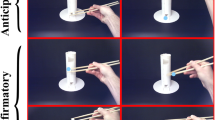Abstract
A number of nonhuman primate species have demonstrated the ability to use a joystick to control a cursor on a computer screen, yet the acquisition of this skill has not been the focus of systematic inquiry. Here, we examined joystick acquisition in four tufted capuchins under two directional relationships of joystick movement and resultant cursor displacement, isomorphic and inverted. To document the natural history of the acquisition of this skill, we recorded the development of visual tracking of the cursor and body tilting. Rates of acquisition were comparable between the two conditions. After mastering the task in one condition, subjects remastered the task at an accelerated rate in the opposing condition. All subjects significantly increased or maintained high proportions of cursor tracking throughout acquisition. All subjects demonstrated a postural tilt while moving the cursor from the mid-phase of acquisition through task mastery. In the isomorphic condition, all subjects tilted significantly more often in the direction of goal location than in the opposite direction. In three of the four series of tilting that were scored for subjects in the inverted condition, tilting occurred significantly more often toward the direction of goal location than the direction of required hand movement. Together these findings suggest that body tilting participates in the organization of directional movement of the cursor rather than reflecting merely the motoric requirements of the task (to manipulate a joystick).





Similar content being viewed by others
References
Andrews MW (1993) Video-task paradigm extended to Saimiri. Percept Mot Skills 76:183–191
Andrews MW, Rosenblum LA (1993) Live-social-video reward maintains joystick task performance in bonnet macaques. Percept Mot Skills 77:755–763
Filion CM, Johnson JS, Fragaszy DM, Johnson R (1994) Studying cognition in tufted capuchins (Cebus apella) using a video-formatted testing paradigm. In: Roeder JJ, Thierry B, Anderson JR, Herrenschmidt N (eds) Current primatology, vol II. Social development, learning, and behaviour. Universite Louis Pasteur, Strasbourg, pp 111–117
Hopkins WD (1991) Laterality in monkeys and apes. In: Ehara A, Kimura T, Takenaka O, Iwamoto M (eds) Primatology today. Elsevier, Amsterdam, pp 271–274
Jorgensen MJ (1995) Investigating the antecedents of self-recognition using a video-task paradigm in capuchins (Cebus apella) and chimpanzees (Pan troglodytes). Dissertation Abstracts International, B55(12), 5553 (UMI No. 9513172)
Jorgensen M, Hopkins WD, Washburn DA, Suomi SJ (1993) Initial performance of Cebus apella on two video tasks: a comparison with Macaca mulatta and Pan troglodytes. Am J Primatol 30:321
Kluver H (1933) Behavior mechanisms in monkeys. University of Chicago Press, Chicago
Menzel CR, Savage-Rumbaugh ES, Menzel EW Jr (2001) Primate geometry (abstract). In: The 18th Congress of the International Primatological Society. Primates in the new millennium. Abstracts and programme. IPS, Adelaide
Menzel EW Jr, Savage-Rumbaugh ES, Lawson J (1985) Chimpanzee (Pan troglodytes) spatial problem solving with the use of mirrors and televised equivalents of mirrors. J Comp Psychol 99:211–217
Newell KM (1991) Motor skill acquisition. Annu Rev Psychol 42:213–237
Poulton EC (1966) Tracking behavior. In: Bilodeau EA (ed) Acquisition of skill. Academic Press, New York, pp 361–410
Poulton EC (1974) Tracking skill and manual control. Academic Press, New York
Richardson WK, Washburn DA, Hopkins WD, Savage-Rumbaugh ES, Rumbaugh DM (1990) The NASA/LRC computerized testing system. Behav Res Methods 22:127–131
Rumbaugh DM, Richardson WK, Washburn DA, Savage-Rumbaugh ES, Hopkins WD (1989) Rhesus monkeys (Macaca mulatta), video tasks, and implications for stimulus-response contiguity. J Comp Psychol 103:32–38
Vauclair J, Fagot J (1993) Manual and hemispheric specialization in the manipulation of a joystick by baboons (Papio papio). Behav Neurosci 107:210–214
Acknowledgements
We thank Christine Orman, Sarah Cummins-Sebree, and Kai McCormack for their assistance in experimental design, data collection, and analysis. We thank the University of Georgia Instrument Shop for the construction of our apparatus. We are grateful to Patrick Ulam for programming assistance, as well as David Washburn and colleagues at the Language Research Center of GSU for programming modifications and hardware. This work was supported by grant no. CHD06106 from the National Institutes of Health of the United States to Georgia State University.
Author information
Authors and Affiliations
Corresponding author
Rights and permissions
About this article
Cite this article
Leighty, K.A., Fragaszy, D.M. Joystick acquisition in tufted capuchins (Cebus apella). Anim Cogn 6, 141–148 (2003). https://doi.org/10.1007/s10071-003-0176-9
Received:
Revised:
Accepted:
Published:
Issue Date:
DOI: https://doi.org/10.1007/s10071-003-0176-9




